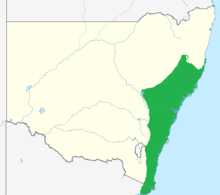
Back Persoonia linearis CEB Persoonia linearis German Persoonia linearis French Persoonia linearis Italian Persoonia linearis Portuguese Persoonia linearis Romanian Persoonia linearis Russian Persoonia linearis Swedish Persoonia linearis WAR
| Narrow-leaved geebung | |
|---|---|

| |
| Scientific classification | |
| Kingdom: | Plantae |
| Clade: | Tracheophytes |
| Clade: | Angiosperms |
| Clade: | Eudicots |
| Order: | Proteales |
| Family: | Proteaceae |
| Genus: | Persoonia |
| Species: | P. linearis
|
| Binomial name | |
| Persoonia linearis | |

| |
| Range of P. linearis in New South Wales and extending into Victoria in eastern Australia | |
| Synonyms[2] | |
Persoonia linearis, commonly known as the narrow-leaved geebung, is a shrub native to New South Wales and Victoria in eastern Australia. It reaches 3 m (9.8 ft), or occasionally 5 m (16 ft), in height and has thick, dark grey papery bark. The leaves are, as the species name suggests, more or less linear in shape, and are up to 9 cm (3.5 in) long, and 0.1 to 0.7 cm (0.039 to 0.276 in) wide. The small yellow flowers appear in summer, autumn and early winter (December to July), followed by small green fleshy fruit known as drupes. Within the genus Persoonia, it is a member of the Lanceolata group of 58 closely related species. P. linearis interbreeds with several other species where they grow together.
Found in dry sclerophyll forest on sandstone-based nutrient-deficient soils, P. linearis is adapted to a fire-prone environment; the plants resprout epicormic buds from beneath their thick bark after bushfires. The fruit are consumed by vertebrates such as kangaroo, possums and currawongs. As with other members of the genus, P. linearis is rare in cultivation as it is very hard to propagate by seed or by cuttings, but once propagated, it adapts readily, preferring acidic soils with good drainage and at least a partly sunny aspect.
- ^ Weston, P. (2020). "Persoonia linearis". IUCN Red List of Threatened Species. 2020: e.T118153874A122769241. doi:10.2305/IUCN.UK.2020-3.RLTS.T118153874A122769241.en. Retrieved 15 October 2022.
- ^ a b Cite error: The named reference
apniwas invoked but never defined (see the help page).
© MMXXIII Rich X Search. We shall prevail. All rights reserved. Rich X Search
